 |
Picks is a monthly sampling of Japan's art scene, offering commentary by a variety of reviewers about exhibitions at museums and galleries in recent weeks, with an emphasis on contemporary art by young artists. |
 |
 |
|
|
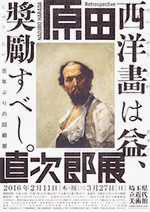 |
|
| Naojiro Harada Retrospective |
| 11 February - 27 March 2016 |
The Museum of Modern Art, Saitama
(Saitama) |
 |
| Naojiro Harada (1863-99) died when he was 36, and after one posthumous show in 1909 his work fell into obscurity; this is his first retrospective in over a century. A Europe-trained Western-style artist, he had the bad luck to return home at a point when Japanese art was undergoing a traditionalist, anti-Western revival. Due to the brevity of Harada's career, there are relatively few works on display. Still, it is surely one of the valuable functions of a public museum to rediscover artists that have fallen into the cracks of history, and the Saitama has stepped up to the plate in this respect. |
|
|
 |
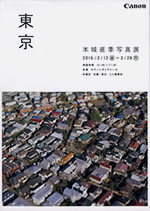 |
|
| Naoki Honjo: Tokyo |
| 12 February - 28 March 2016 |
Canon Gallery S
(Tokyo) |
 |
| Honjo's show combined photos shot with a large-format analog camera as well as more recent work using the high-res, mega-pixel Canon EOS5Ds. The digital single-lens reflex camera has liberated the photographer, imbuing his new work with a free-and-easy vibe of "snapping Tokyo." Honjo seems to have hit on a method of capturing, from a variety of angles, the endless mutations of the relentlessly proliferating megalopolis. |
|
|

|
 |
 |
|
 |
 |
 |
| Yuji Takeoka: From a Pedestal into Space |
| 16 January - 21 March 2016 |
The National Museum of Art, Osaka
(Osaka) |
 |
| This is a first retrospective for contemporary artist Takeoka, who was born and raised in Kyoto but went to Germany to study and has since worked primarily out of Dusseldorf and Bremen. At first sight calling to mind the minimal art of the sixties, Takeoka's works are more accurately described as "pedestal sculptures" -- speculative endeavors consisting solely of the dais that a work of art sits on, minus the work itself yet somehow implying its presence through absence. |
|
|
|
|
|
|
|

|
 |
 |
 |
 |
| Yukio Fujimoto: Broom (Coal) / Tokyo |
| 6 February - 6 March 2016 |
ShugoArts Weekend Gallery
(Tokyo) |
 |
| The gallery floor is covered with a disk-like array of black stones. From their luster, you realize they are pieces of coal. As you walk over the coal, producing loud crunching sounds, it feels as if you are the needle moving across a huge phonograph record. This is the latest in Fujimoto's series of "Broom" installations, which he began by covering a floor with dead leaves. After going through several permutations in shape and material, he arrived at coal, he says. |
|
|
 |
 |
| Shinji Sasaki Exhibition: Song of the Great River |
| 26 - 31 January 2016 |
Gallery Keifu
(Kyoto) |
 |
| Upon graduation from college Sasaki immediately left for India, where he fell in love with the country's unforgiving natural environment and the dramatic joys and sorrows of those who survive in it. Since then he has visited India every two years or so and has made it an ongoing theme of his paintings. Though conceived in an orthodox style of line-drawn Nihonga, his work glows with the inspiration he has absorbed through all five senses and brims with a persuasive power that transcends mere exoticism. |
|

|
 |
 |
 |

|
|
| Precision Artistic Crafts for Adornment |
| 21 November 2015 - 14 February 2016 |
Kiyomizu Sannenzaka Museum
(Kyoto) |
 |
| An exhibit of some 80 personal ornaments of a bygone age, including swords, hairpins, combs, and inro seal cases redolent of the Edo period, as well as pocket watches, cufflinks, pendants, and rings that reflect the influx of Western fashion in the Meiji era. Nearly everything on display is small enough to fit, or be held, in the hand. Indeed, it is the stately appearance of the smallest items that seems to embody the pride and commitment of these artisans, whose work was a manifestation in miniature of their country's destiny. |
|
|
 |
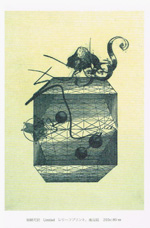 |
 |
| Mitsuo Kano |
| 15 - 27 February 2016 |
Galerie Petit Bois
(Osaka) |
 |
| A thoroughgoing retrospective offering some 100 prints and drawings by Kano (b. 1936), whose illustrations adorned many postwar Japanese magazines. Most of his work consists of small monochrome line drawings that combine such motifs as animals and geometric figures. The prints on display are mainly illustrations for publications from the 1970s, while the drawings are unpublished; all were obtained from Kano's personal collection. |
|
|
|
|
|
|
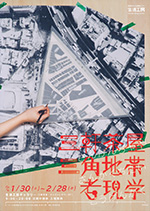 |
 |
The Triangle of Sangenjaya |
30 January - 28 February 2016 |
Lifestyle Design Center
(Tokyo) |
 |
| The Sangenjaya Triangle, a cramped Tokyo entertainment quarter of mazelike alleys that's a holdover from a postwar black market district, gets the "modernology" treatment -- kogengaku or modernology being a term coined by the architect Wajiro Kon (1888-1973) for the study of modern social phenomena, particularly in cities. Handwritten charts, maps, illustrations and other exhaustive documentation offer insights that make a visitor to the Triangle (for a post-exhibition drink, of course) view the neighborhood through a different lens. |
|
 |
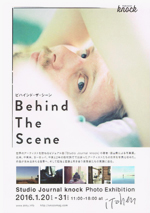 |
 |
| Studio Journal knock Photo Exhibition |
| 20 - 31 January 2016 |
iTohen
(Osaka) |
 |
| In July 2013, Fukuoka-based graphic designer Isao Nishiyama and his wife Mami set off on a two-year junket, visiting and interviewing artists they met all over the world, then self-publishing those interviews in the magazine Studio Journal knock. This show featured some 50 photos by Nishiyama from the pages of the magazine. Interviewing unfamiliar people in unfamiliar places might sound like a stressful undertaking, but that notion is belied by these pictures, with their air of relaxed informality and intimacy. |
|
|
|
|
 |
|